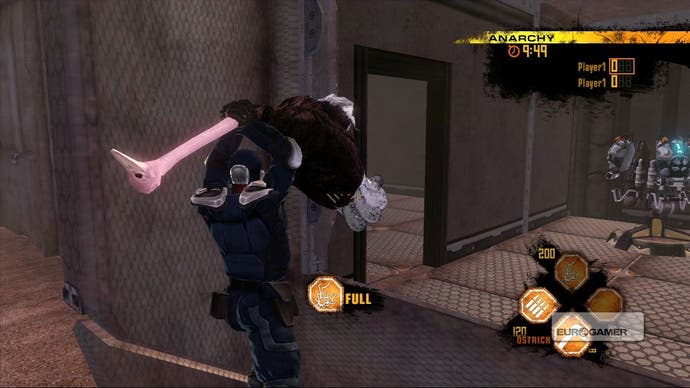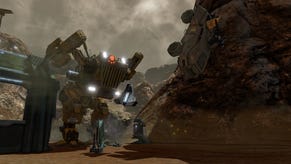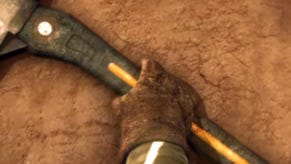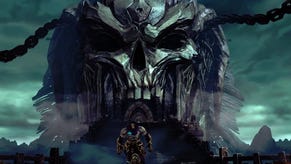Red Faction: Guerrilla
Hammer time.
An actual gunfight is also one of the weakest parts of the game, at least at this stage. There's a basic cover system, and with the left trigger reserved for melee attacks, your valuable iron-sights zoom is a right-stick click. With limited ammo on the beefy weapons (which themselves take a while to unlock thanks to the surprisingly sparse "salvage" currency pickups), you generally opt for the assault rifle, and it and the enemy AI are a touch weedy. Your adversaries are dangerously accurate in numbers, but tactically basic and sometimes a bit dim-witted, guilty of traditional sins like walking repeatedly up against walls. Halo with next-gen physics this is not. Vehicles aren't massively exciting over the first half a dozen hours either - most handle pretty agriculturally, and there's quite a lot of to-ing and fro-ing between safehouses and objectives, relying on the "quest arrows" that resemble GTA's overlaid GPS route.
Fortunately the mission variety sustains it, and RFG begins to overcome these concerns. The way the gradual weakening of EDF influence and control feeds back into your progress is also tangible, and not just thanks to the diminishing "control" and rising guerrilla "morale" bars on opposing sides of the map screen. Faced with a mission in Dust - the brighter and larger second territory after the initial Parker township - that asks you to take out an EDF commander and prevent him broadcasting misleading messages to your comrades, you're often overrun and killed in your attempts to get close enough to individual radio transmitters and mine them. But after gathering enough salvage to buy a rocket launcher, and encouraging more guerrilla support through morale boosts, it's much easier to complete.
Were you to bounce off it repeatedly, it would wear you down in much the same way some of the tougher, pivotal missions in GTA and other openworld games have done in the past. However, RFG never leaves you with just one thing to do, and the side missions are more developed than is traditional. One Dust mission, for instance, involves riding shotgun around a quarry in the back of a sort of Scrapheap Challenge Trans-Am carpeting designated EDF targets, the pursuing APCs and overhead dropships in rockets, with the goal of doing 35 million credits' worth of damage. Thanks to the severity of the weaponry and consequent extravagance of the convincingly modelled destruction, it's a blast, even if you have to attempt it two or three times on normal difficulty.

Other side missions include against-the-clock destruction tasks - positioning barrels by hand and detonating them with a pistol to undermine an old watchtower, for example, or breaking up a small building using nothing but the sledgehammer. These have a par time and a bonus time, and pay out with lots of salvage. As you grow to understand the subtleties of your demolition equipment and the structural weaknesses betrayed by RFG's coherent architectural style, it becomes easier to get the most out of them, and there's almost a high-scores buzz to repeat play, which the game is happy to cue up, reassembling your flattened target on the other side of a load-screen.
Elsewhere you encounter vehicles that need to be driven to safehouses against the clock, and the game throws in a lot of ad hoc missions, so even as you settle into the rhythm of picking out and journeying to specific tasks on the map, a pop-up and voice-over clues you into to something a bit more interesting, like a travelling EDF convoy that you're invited to ambush. With multiple, relatively hard-nosed trucks to take out and explosives limited by your available upgrades, these inspire a bit of creativity, and it's in some of these sections that Volition seems to best understand what it's got on its hands in GeoMod 2.0.

Even so, there's a shakiness to Red Faction: Guerrilla over its first six hours. Realistic physics have been at the heart of gaming's evolution for many years now - from the crude crate-knocking and ragdoll physics of games like Max Payne 2, through Half-Life 2's prodigious amplification of cause-and-effect. Red Faction: Guerrilla hopes to be the next mark on that timeline, and in the core of its technology it has that potential. But it's utilitarian, struggling in its opening sections to deliver storyline and core shooter and openworld mechanics that mark it out in those areas. The hope is that, as it grows in scale and ambition across its seemingly impressive length, it will either address these shortfalls or overcome them with the application of its miraculous technology.
Red Faction: Guerrilla is due out for PS3, Xbox 360 and PC on 5th June.





